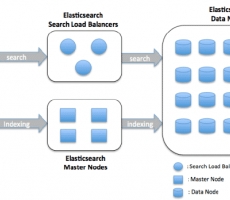-
Read More

A Node.js speed dilemma: AJAX or Socket.IO?
Written by CUBRID Community on 07/14/2017 One of the first things I stumbled upon when I started my first Node.js project was how to handle the communication between the browser (the client) and my middleware (the middleware being a Node.js application using the CUBRID Node.js driver (node-cubrid) to exchange information with a CUBRID 8.4.1 database). I am already familiar with AJAX (btw, thank God for jQuery!!) but, while studying Node.js, I found out about the Socket.IO module and even found some pretty nice code examples on the internet... Examples which were very-very easy to (re)use... So this quickly becomes a dilemma: what to choose, AJAX or sockets.io? Obviously, as my experience was quite limited, first I needed more information from out there... In other words, it was time to do s... -
Read More

Our Experience of Creating Large Scale Log Search System Using ElasticSearch
Written by Lee Jae Ik on 05/01/2018 At NHN, we have a service called NELO (NHN Error Log System) to manage and search logs pushed to the system by various applications and other Web services. The search performance and functionality of NELO2, the second generation of the system, have significantly been improved through ElasticSearch. Today I would like to share our experience at NHN in deploying ElasticSearch in Log Search Systems. ElasticSearch is a distributed search engine based on Lucene developed by Shay Banon. Shay and his team have recently released the long-awaited version 0.90. Here is a link to a one-hour recorded webinar where Clinton Gormley, one of the core ElasticSearch developers, explains what's new in ElasticSearch 0.90. If you are developing a system which requires a searc... -
Read More

CUBRID License Model
Written by Charis Chau on 06/08/2020 Why Licenses Matter? Open source licenses allow software to be freely used, modified, and shared. Choosing a DBMS with suitable licenses could save the development cost of your application or the Total Cost of Ownership (TCO) for your company. Choosing a DBMS without a proper license, you might find yourself situate in a legal grey area! CUBRID Licenses Unlike other open source DBMS vendors, CUBRID is solely under open source license instead of having a dual license in both commercial license and open source license. Which means that for you, it is not mandatory to purchase a license or annual subscription; company/organizational users can achieve the saving from Total Cost of Ownership (TCO). Since CUBRID has been open source DBMS from 2008,... -
Read More

Contributing to Open Source Community/Project
Written by Charis Chau on 06/23/2020 What is an open source project? To answer this, let us start with a burger! Imagine an open source project is a burger selling in a restaurant. Every day, the chef makes thousands of burgers that have the same quality by following the same recipe from the restaurant. One day, customer A comes to the burger place to try the burger, and he/she loves it! Therefore, customer A decides to ask the chef whether he/she can get the recipe. Here, if the restaurant is open source, they will be happy to share the recipe to customer A, vice versa. After customer A gets the receipt, he/she decide to make the burger at home by him/herself! However, customer A is a meat lover and does not like onion that much, so he/she decide to change the recipe by taking o... -
Read More

Preventing Sniffing by CUBRID- Packet Encryption
Written by Youngjin Hwang on 05/11/2021 Nowadays, browsing the internet with PCs or our smartphones has become an essential part of our daily life. As a result, it is possible to peek into the data being transmitted over the Internet with malicious intent. In other words, being able to peek at the data being transmitted by someone is called sniffing. A classic example of a sniffing attack would be intercepting the account’s id and password and causing physical damage by using the personal information of others. To protect our database user data, CUBRID 11.0 has enhanced security by providing packet encryption (and TDE (Transparent Data Encryption) based data encryption, but that will be cover in another blog later). When packet encryption is applied, the packet is encrypted and tran...



